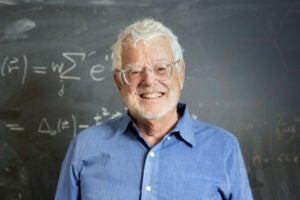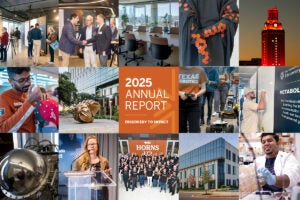In his inaugural speech, President Gregory L. Fenves challenged the top researchers at The University of Texas at Austin to tackle the toughest questions facing humanity. To do that, he said, the university must tear down silos of knowledge and unleash the potential of the campus as a whole.
To facilitate this goal, the Office of the Vice President for Research launched the Bridging Barriers initiative to encourage more research across disciplines.
“Universities have been tremendously successful over the last 500 years by having specialization. Deep knowledge comes with specializing and becoming the expert in your field. It’s terribly important,” says Dan Jaffe, vice president of research at UT Austin. “But what we don’t do quite so well is find ways to approach problems that touch on many disciplines.”
If we want to be able to tackle world problems, we have to find a way to bring people together, he says.
UT Austin is not alone in this thinking. To respond to pressing global problems, top research universities are uniting experts with “grand challenges” programs.
These programs want to translate research into impact for issues ranging from energy resources to aging.
Unlike other universities, UT’s Bridging Barriers program is taking a bottom-up approach. The university is looking to the researchers to pick problems that can be best solved using the unique resources and skills at UT Austin.
Rather than starting with one problem and hosting a more straightforward competition, Bridging Barriers wants to match the greatest minds on campus and empower them to lead world-changing research.
Working across disciplines doesn’t always come naturally. There aren’t many opportunities for an engineer and a historian to connect in their respective day-to-day work. The first phase of Bridging Barriers wanted to facilitate that kind of cross-disciplinary interaction.
The initiative kicked off by asking the researchers to submit concept papers describing research grand challenges that inspired them. Then they were matched based on intersecting goals, connecting hundreds of researchers who had never met before.
“We were a little nervous because we weren’t sure how many people would respond,” said Jaffe.
The response was overwhelming: 830 unique authors working on 125 concept papers from 16 schools and colleges across the university.
Then came the hard part – matching up the concept papers. That task fell to Jennifer Lyon Gardner, assistant vice president for research and the “intellectual and organizational driver of the initiative,” said Jaffe.
“We worked hard to put together creative cross-disciplinary teams. There’s a tendency to want to organize the papers topically, but when you do that, you end up with all the health papers in the same bucket, which just creates the silos all over again,” said Lyon Gardner.
Six core themes emerged – each containing 25 or more papers and a few hundred researchers.
“This is a research mixer,” said Lyon Gardner. “We definitely are cautious not to do any sort of forced marriages.” Some concept papers appeared in more than one theme or occasionally, all six, to allow for organic partnerships to develop.
Bridging Barriers Themes
A BETTER AND LONGER LIFE EXPERIENCE
DISPROPORTIONALITY AND SOCIAL CHANGE
AN ADAPTIVE INTELLIGENT CARE SYSTEM
Each theme was introduced to the campus using a town hall format this spring. They were led by a panel of five to seven concept paper authors, representing a cross section of the papers – from dramatists to doctors, classicists to computer scientists.
Incorporating feedback from those meetings, the different groups will meet this summer to define research questions, establish goals, develop the leadership team and start fundraising.
The Office of the Vice President for Research will provide shared collaborative space on campus so the teams can work on their projects.
“But it’s not an institute,” said Jaffe. “We’re not going to put up a brick and mortar thing with gold leaf letters on it that will last forever.” Instead, each theme’s project should be completed within five to 10 years.
Jaffe believes this large-scale research collaboration will benefit both society and the academics participating.
“There is a lot of excitement,” he says. “The growth of knowledge that expands the boundaries of what we know, and that ultimately can be used to devise solutions for tomorrow’s problems, is incredibly important. This program will allow faculty members to test their ideas in new ways. They’re no longer just down there in their little niche by themselves. But they’re being banged up against other things that force them to toughen their arguments and to broaden the case for why what they’re doing is relevant.”
Themes will be working through the summer in anticipation of launching the first group in the fall.
For researchers and members of the UT community who want to read the concept papers or are interested in getting involved, go to research.utexas.edu and click on the Bridging Barriers photo to learn more.




